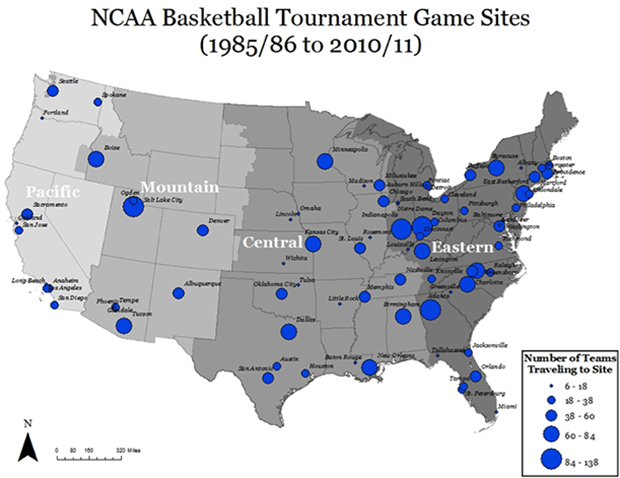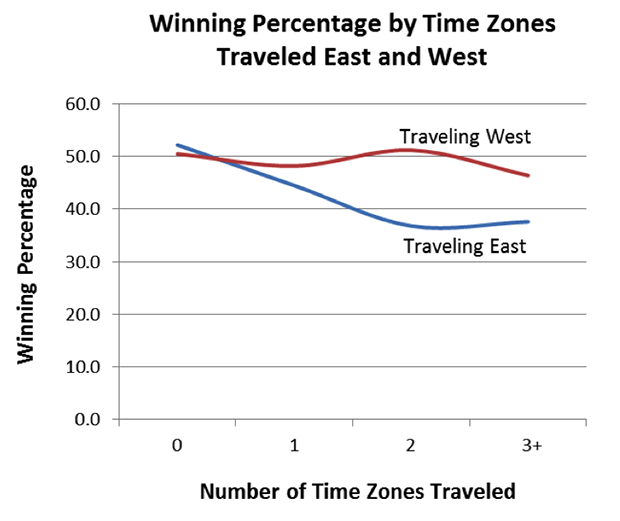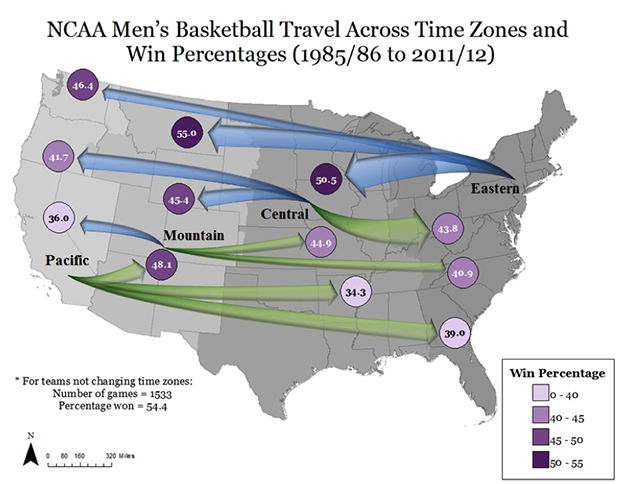By: Daniel C. Clay, Aniseh S. Bro, and Nathan J. Clay
Key Insights
- The decline in winning percentage is most precipitous for tournament teams that travel east, dropping to below 38% for teams crossing two or more time zones.
- The easterly time zone disadvantage may be due to the fact that early round tournament games tend to be played during the day, thus closer to the “body-clock sweet spot” of the eastern teams.
- It was surmised that traveling to a higher elevation would reduce the odds of winning, as has been witnessed in other sports, yet this effect is not borne out in NCAA Tournament play.
- Traveling more than 150 miles from home reduces the odds of winning to 0.664, or 33.6% less than for those who play in their home regions.
- This model reveals that the shift to the pod format in 2002 has no significant independent effect on tournament results, but does reward fans who can now stay closer to home than in the past.
A fact of collegiate sports competition is that teams and individual athletes must travel through time and space to play against one another. This can mean voyaging thousands of miles and across multiple time zones to compete, often enduring significant changes in elevation and climate. Such travel can also mean that teams will play far from the coveted advantages of their home regions and the comfort of a friendly fan base.
Of course the Tournament Selection Committee is well aware of some of the disadvantages of travel and takes steps to incorporate the disadvantages into the seeding process. In 2002 they adopted a “pod” format that enables teams to play the earlier rounds of the tournament in cities geographically distant from their regional brackets. As a result of the pod system, higher seeds now travel shorter distances for the first two rounds of the tournament and their winning percentages in these rounds have increased as a result. 1 Here we take a fresh look at the effects of the pod system in the context of the full range of geospatial changes that teams encounter in NCAA Tournament play.
Our overall guiding assumption in this analysis is that geospatial change is disruptive and disadvantageous, and that the greater the change in traveling to the game site, measured in terms of distance from home region, time zones crossed, higher elevation and change in temperature, the lower will be the odds of winning.
We draw upon 3,296 individual team performances from all 1,648 NCAA Division I Men’s Basketball Tournament games played over 26 years beginning with the 1985/86 season when the NCAA moved to the 64 team format and ending with the 2010/11 season. Represented in this data are 278 teams from 38 college basketball conferences in the US and playing at 83 different tournament sites. All sites and team movements have been geocoded to enable the computation of distances as well as changes in time zones and average temperatures (in March).
Our analysis combines all of our study variables in a logistic regression model with the intention of sorting out the independent effects of each of the geospatial variables on game outcomes while controlling for team strength (seed) and the effects of the pod era changes in site selection. This is a critical and necessary step, as not all teams endure the same degree of geospatial change in their travels to the host site. Indeed, we know that stronger teams are purposefully spared the agony of long distance travel, whenever possible, and especially so since the start of the 2002 pod era.
From the logistic regression model results presented in Table 1 we observe that traveling east across time zones significantly reduces the odds of winning (odds ratio of .861), or 13.9% lower than for those not traveling east. Traveling west also reduces the odds of winning but not significantly. Table 1 also shows that elevation and temperature change do not affect NCAA tournament game outcomes, when team strength and other model variables are controlled.
It was surmised that traveling to a higher elevation would reduce the odds of winning, as has been witnessed in other sports, yet this effect is not borne out in NCAA Tournament play. By contrast, home region advantage, measured as binary variable (inside vs. outside of a 150 mile radius), does exert the expected strong effect on game outcomes. Traveling more than 150 miles from home reduces the odds of winning to 0.644, or 33.6% less than for those who play in their home regions.
Table 1. Logistic Regression Estimating Game Outcomes by Geo-Spatial Changes, Tournament Seed, Round and Pod Era Brackets
| Variable in Equation | B | S.E. | Wald | Sig. | Odds Ratio Exp(B) |
| Time zones traveled east | -.150 | .064 | 5.486 | .019* | .861 |
| Times zones traveled west | -.065 | .057 | 1.283 | .257 | .937 |
| Elevation change (ft) | .000 | .000 | 1.253 | .263 | 1.000 |
| Temperature change (°F) | .003 | .004 | .483 | .487 | 1.003 |
| Distance traveled | -.440 | .154 | 8.181 | .004** | .644 |
| Strength of team (seed) | -.279 | .011 | 599.792 | .000** | .757 |
| Tournament round | -.483 | .038 | 164.359 | .000** | .617 |
| Pod era game (2002+) | .002 | .084 | .001 | .982 | 1.002 |
| Constant | 3.237 | .194 | 278.128 | .000** | 25.448 |
**Significant at the 0.01 level (2-tailed). *Significant at the 0.05 level (2-tailed).
Finally, this model reveals that the shift to the pod format in 2002 has no significant independent effect on tournament results. In short, higher seed teams were about as likely to win before the format change as after it, meaning that the shorter distances now traveled by high seed teams does not translate into more wins, but are still a deserving reward for the fans of these teams who can now stay closer to home than in the past.
A closer look at the time zone effect. All tournament sites are mapped in Figure 1 with the symbol sizes increasing with the number of teams traveling to each site for tournament play across all rounds. Cities such as Atlanta, Indianapolis and Salt Lake City stand out as perennial host sites known to fans across the country.
Figure 1:
Time zone effects on sports performance have drawn much attention but most notably in how crossing time zones disrupts our body clocks (circadian rhythms). Research shows that peak performance tends to occur in the late afternoon and early evening (4:00-8:00 pm) and suggests that travel across time zones that favors one team over another in terms of playing during this “biorhythmic sweet spot” can be seen in sports outcomes. Figure 2 compares winning percentages by the number of time zones traveled for NCAA tournament teams traveling east and for those traveling west, controlling for no other variables. While there is a slight decline in outcomes for teams going west, the decline is precipitous for tournament teams that travel east, dropping to below 38%, poor odds indeed, for teams crossing two or more time zones.
Figure 2:
To help visualize these movements geographically Figure 3 maps direction of travel, number of time zones crossed, volume of team travel and win percentage for the instances of team travel from one time zone to the next. Win percentages are generally in the lower categories for teams traveling east and higher for teams traveling west. For example, teams traveling from the Mountain time zone win only 40.9% of their games played in the Eastern time zone compared to a 55.0% winning rate for teams traveling in reverse, from the Eastern to Mountain time zones. A second observation taken from this map is that the volume of travel is greater for games played just one time zone away compared to those requiring teams to cross two or three time zones to play. This stands to reason given the Selection Committee’s commitment to keeping teams, especially higher seeds, close to home whenever possible.
Figure 3:
What is most intriguing is that these results run counter to the NFL Monday Night Football findings that report an advantage to easterly travel. We believe the difference lies in the time of day that the games are played. Monday Night Football games are played at night, sometimes very late at night in the eastern time zone (9:00-12:00 midnight), enabling west coast teams to benefit by playing during the high performance hours of their circadian rhythms (4:00-8:00 pm).
NCAA tournament basketball, however, is played throughout the day, particularly for the early rounds, when over three fourths of the games are played. The majority of these games are played in the afternoon, enabling eastern teams to compete during or closer to the hours of their biorhythmic sweet spot than teams from farther west. As a consequence the “jet lag” effect is minimized for those teams traveling from east to west. So the message we send to the Selection Committee is that the time of day that NCAA Tournament games are scheduled can favor one team over another when they originate from different time zones.
A closer look at the “pod format” effects. To examine the impact of the pod format adopted by the NCAA Selection Committee in 2002 to advantage the higher seeded teams with closer-to-home tournament sites, we plotted the distance travelled by two seed groups, high seeds (1-4) and lower seeds (5-16), over the 26 year period. Only data for the rounds of 64 and 32 are plotted as the pod system is primarily targeted to these two rounds. Together they account for 76% of all tournament games played.
Figure 4:
Figure 4 shows that the higher seeds have historically had relatively shorter travel distances than lower seeds in most years (average 128 fewer miles). The introduction of the pod format in 2002 has resulted in even greater separation of the two seed groups. The top four seeds now travel 435 fewer miles on average compared to the lower seed group. We also find that the change in format led to a slightly higher winning percentage among the top seeds in the first two rounds of Tournament play, rising from 79.1 percent before 2002 to 80.5 percent since that time. However, this improvement in winning percentage is shown to be statistically insignificant in the logistic regression model, once the effects of other variables in the model are held constant.
Conclusion:
It is imperative that coaches and players be aware of what long distance travel means to performance on the court and how its negative effects can be mitigated. And how these geospatial determinants are taken into consideration by the NCAA Tournament Selection Committee in establishing brackets is no small matter. Who travels and who stays home and in which direction they travel and at what time of day they play are all shown to be critically important to the Committee’s efforts to fairly seed and place tournament teams across geographical regions.
We give special thanks to Daniel C. Clay, Aniseh S. Bro, and Nathan J. Clay for their contribution to this article.
 Daniel Clay – Dan is a professor in the Department of Community Sustainability at Michigan State University. He is accomplished in the analysis of large-scale data sets in socioeconomic research. He leads an interdisciplinary team in sports analytics focused on coach-controlled, ecological, and on-court determinants of success in men’s college basketball.
Daniel Clay – Dan is a professor in the Department of Community Sustainability at Michigan State University. He is accomplished in the analysis of large-scale data sets in socioeconomic research. He leads an interdisciplinary team in sports analytics focused on coach-controlled, ecological, and on-court determinants of success in men’s college basketball.
 Aniseh Bro – Aniseh is a statistician and PhD candidate in the Department of Community Sustainability at Michigan State University. She serves as a research assistant on projects in sports analytics and international development at MSU.
Aniseh Bro – Aniseh is a statistician and PhD candidate in the Department of Community Sustainability at Michigan State University. She serves as a research assistant on projects in sports analytics and international development at MSU.
 Nathan Clay – Nathan is a PhD candidate in the Geography Department at Penn State University. He is an expert in spatial analysis and GIS applications in a range of research areas including ecology, socioeconomics and sports analytics.
Nathan Clay – Nathan is a PhD candidate in the Geography Department at Penn State University. He is an expert in spatial analysis and GIS applications in a range of research areas including ecology, socioeconomics and sports analytics.
References:
- Buikema, Kevin. 2012. “The Pod System: For Once, The NCAA Got Something Right. | Stat Geek Idol.” Team Rankings: Get Smart about Sports. Last modified March 21, 2012. http://www.teamrankings.com/blog/ncaa-basketball/the-pod-system-for-once-the-ncaa-got-something-right-stat-geek-idol.
McFall, Todd and Stephen G. Bronars. 2012. “Pod System in Men’s NCAA Basketball Tournament — What Is the Impact on Performance? Winthrop Intelligence. Last Modified February 28, 2012. http://winthropintelligence.com/2012/02/28/pod-system-in-mens-basketball-tournament-what-is-the-impact-on-performance/. ↩








